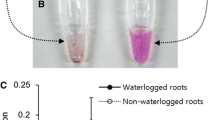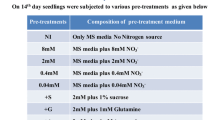Abstract
Two tobacco lines with (Nicotiana tabacum cv. Gatersleben, WT) or without (transformant LNR-H) nitrate reductase in roots were chosen as model systems to re-evaluate the role of root nitrate reduction for survival of anoxia. In this first paper, the two hydroponically grown lines were compared with respect to their root morphology, root respiration and the root content of inorganic cations, anions, and metabolites. Leaf transpiration in relation to root morphology was also determined. In comparison to WT roots containing NR, the NR-free LNR-H transformants had slightly shorter and thicker roots with a lower root surface area per g leaf FW. Consistent with that, LNR-H leaves had lower transpiration rates than WT. LNR-H-roots also showed consistently higher respiration and higher contents of ATP, starch and hexose monophosphates than WT roots. Concentrations of free sugars were only slightly higher in LNR-H roots. Total soluble protein content was identical in both lines, whereas amino acids were higher in LNR-H. Contents of major inorganic cations and anions were also almost identical in both lines. We conclude that WT versus LNR-H plants are a suitable tool to re-evaluate the role of nitrate reduction in flooding tolerance.
Similar content being viewed by others
References
Apostolova E and Georgieva M 1990 Effect of nitrate and ammonium on the accumulation of biomass nitrogen and ash elements in the overground parts and roots of Virginia cultivar tobacco. Pochvoznanie I Agrochimia25, 47-54.
Arnon D I 1937 Ammonium and nitrate nitrogen nutrition of barley at different seasons in relation to hydrogen ion concentration, manganese, copper and oxygen supply. Soil Sci. 44, 91-121.
Back E 1996 Regulation of root:shoot ratio by cytokinins from roots in Urtica dioica. Opinion. Plant Soil 185, 3-12.
Botrel A and Kaiser W M 1997 Nitrate reductase activation state in barley roots in relation to the energy and carbohydrate status. Planta 201, 496-501.
Botrel A, Magne C and Kaiser W M 1996 Nitrate reduction, nitrite reduction and ammonium assimilation in barley roots in response to anoxia. Plant Physiol. Biochem. 34, 645-652.
Cheeseman J M 1993 Plant growth modeling without integrating mechanisms. Plant Cell Environ. 16, 137-147.
Cooper H D and Clarkson D T 1989 Cycling of amino nitrogen and other nutrients between shoots and roots in cereals: a possible mechanism integrating shoot and root in the regulation of nutrient uptake. J. Exp. Bot. 40, 753-762.
Crawford N M 1995 Nitrate: nutrient and signal for plant growth. Plant Cell 7, 859-868.
Cruz C, Lips S H and Martins-Loucao M A 1997 Changes in the morphology of roots and leaves of carob seedlings induced by nitrogen source and atmospheric carbon dioxide. Ann. Bot. 80, 817-823.
Drew M C, Saker L R and Ashley T W 1973 Nutrient supply and the growth of the seminal root system in barley. I. The effect of nitrate concentration on the growth of axes and laterals. J. Exp. Bot. 24, 1189-1202.
Fitter A H 1985 Functional significance of root morphology and root system architecture. In Ecological Interactions in Soil, Special publication of the British ecological survey No 4, 87-106, Blackwell Scientific, Oxford.
Forde B and Lorenzo H 2001 The nutritional control of plant development. Plant Soil 232, 51-68.
Fox G G, McCallan N R and Ratcliffe R G 1995 Manipulating cytoplasmic pH under anoxia: a critical test of the role of pH in the switch from aerobic to anaerobic metabolism. Planta 195, 324-30.
Foyer C H, Lescure J C, Lefebvre C, Morot G J F, Vincentz M and Vaucheret H 1994 Adaptations of photosynthetic electron transport, carbon assimilation and carbon partitioning in transgenic Nicotiana plumbaginifolia plants to changes in nitrate reductase activity. Plant Physiol. 104, 171-178.
Friend A L, Eide M R and Hinckley T M 1990 Nitrogen stress alters root proliferation in Douglas fir seedlings. Can. J. For. Res. 20, 1524-1529.
Gojon A, Dapoigny L, Lejay L, Tillard P and Rufty T W 1998 Effects of genetic modification of nitrate reductase expression on 15NO3 uptake and reduction in Nicotiana plants. Plant Cell Environ. 21, 43-53.
Hackett C 1972 A method of applying nutrients locally to roots under controlled conditions and some morphological effects of locally applied nitrate on the branching of wheat roots. Aust. J. Biol. Sci. 25, 1169-1180.
Hänsch R, Gómez Fessel D, Witt C, Hesberg C, Hoffmann G, Walch-Liu P, Engels C, Jörg Kruse, Rennenberg H, Kaiser W M and Mendel R R 2001 Tobacco plants that lack expression of functional nitrate reductase in roots show changes in growth rates and metabolite accumulation. J. Exp. Bot. 52, 1251-1258.
Imsande J and Touraine B 1994 N demand and the regulation of nitrate uptake. Plant Physiol. 105, 3-7.
Johnson C, Stout P, Broyer T and Carlton A 1957 Comparative chlorine requirements of different plant species. Plant Soil 8, 337-353.
Kronzucker H J, Schjoerring J K, Erner Y, Kirk G J D, Siddiqi M Y and Glass A D M 1998 Dynamic interaction between root NH4 + influx and long distance N translocation in rice: Insights into feedback processes. Plant Cell Physiol. 39, 1287-1293.
Lang B and Kaiser W M 1994 Solute content and energy status of roots of barley plants cultivated at different pH on nitrate-or ammonium-nitrogen. New Phytol. 128, 451-459.
Roberts J K M, Callies J, Jardetzky O, Walbot V and Freeling M 1984 Cytoplasmic acidosis as a determinant of flooding intolerance in plants. Proc. Natl. Acad. Sci. USA 81, 6029-33.
Scheible W R, Lauerer M, Schulze E D, Caboche M and Stitt M 1997 Accumulation of nitrate in the shoot acts as a signal to regulate shoot-root allocation in tobacco. Plant J. 11, 671-691.
Stoimenova M, Libourel I G L, Ratcliffe R G and Kaiser WM 2002 The role of nitrate reduction in the anoxic metabolism of roots. II. Anoxic metabolism of tobacco roots with or without nitrate reductase activity. Plant Soil 253, 155-167.
Walch-Liu P, Neumann G and Engels C 2001 Response to shoot and root growth to supply of different nitrogen forms is not related to carbohydrate and nitrogen status of tobacco plants. J. Plant Nutr. Soil Sci. 164, 97-103.
Author information
Authors and Affiliations
Corresponding author
Rights and permissions
About this article
Cite this article
Stoimenova, M., Hänsch, R., Mendel, R. et al. The role of nitrate reduction in the anoxic metabolism of roots I. Characterization of root morphology and normoxic metabolism of wild type tobacco and a transformant lacking root nitrate reductase. Plant and Soil 253, 145–153 (2003). https://doi.org/10.1023/A:1024563507275
Issue Date:
DOI: https://doi.org/10.1023/A:1024563507275




